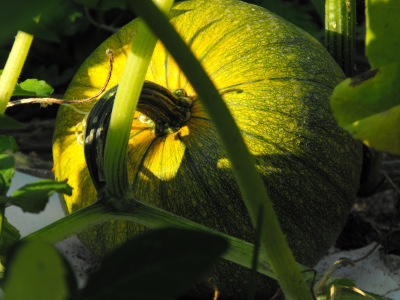
Planning and Planting Storage Vegetables
 Although
a lot of fruits and vegetables can be saved for a few weeks or even a
couple of months in the fridge after harvest, I'm most interested in
the ones that will stay fresh long into the cold months. White
and sweet potatoes, winter squashes (including pumpkins), carrots,
onions, and garlic are the obvious six. We're starting to
experiment with some other good keepers too, including beets, cabbage,
parsnips, and turnips. Once our trees mature, we'll add apples
and pears to the mix.
Although
a lot of fruits and vegetables can be saved for a few weeks or even a
couple of months in the fridge after harvest, I'm most interested in
the ones that will stay fresh long into the cold months. White
and sweet potatoes, winter squashes (including pumpkins), carrots,
onions, and garlic are the obvious six. We're starting to
experiment with some other good keepers too, including beets, cabbage,
parsnips, and turnips. Once our trees mature, we'll add apples
and pears to the mix.
You should start
thinking about winter storage while planning your garden. First,
take a look at your soil conditions. Did you know
that soil with higher levels of potassium will produce vegetables with
better storage quality? (Add manure, compost, wood ashes,
comfrey, and
citrus peels to increase your potassium levels.) Too much
nitrogen in
the soil will have the opposite effect on root crops since the
vegetables will be watery and will spoil quickly.
Next, consider planting
dates. Your goal should be to have your storage crops ripening in
early to late fall, just in time to tuck them away for the winter
without any risk of them becoming overmature. The spring carrots
I've been munching on all summer are now starting to get woody and
bitter --- no point in storing vegetables already past their peak
perfection. Instead, I planted
a fall garden
with storage carrots that are just now starting to ripen.
Although I didn't think this far ahead in spring, I should have planted
my winter squash at the end of May rather than at the end of April, so
that the squash would be turning ripe in Sepetember rather than having
sat in the rain and started to rot for a few weeks before
harvest. Basically, you should plant your storage vegetables as
late as possible to still get a mature crop.
| This post is part of our Storage Vegetables lunchtime series.
Read all of the entries: |
Want more in-depth information? Browse through our books.
Or explore more posts by date or by subject.
About us: Anna Hess and Mark Hamilton spent over a decade living self-sufficiently in the mountains of Virginia before moving north to start over from scratch in the foothills of Ohio. They've experimented with permaculture, no-till gardening, trailersteading, home-based microbusinesses and much more, writing about their adventures in both blogs and books.
Want to be notified when new comments are posted on this page? Click on the RSS button after you add a comment to subscribe to the comment feed, or simply check the box beside "email replies to me" while writing your comment.
